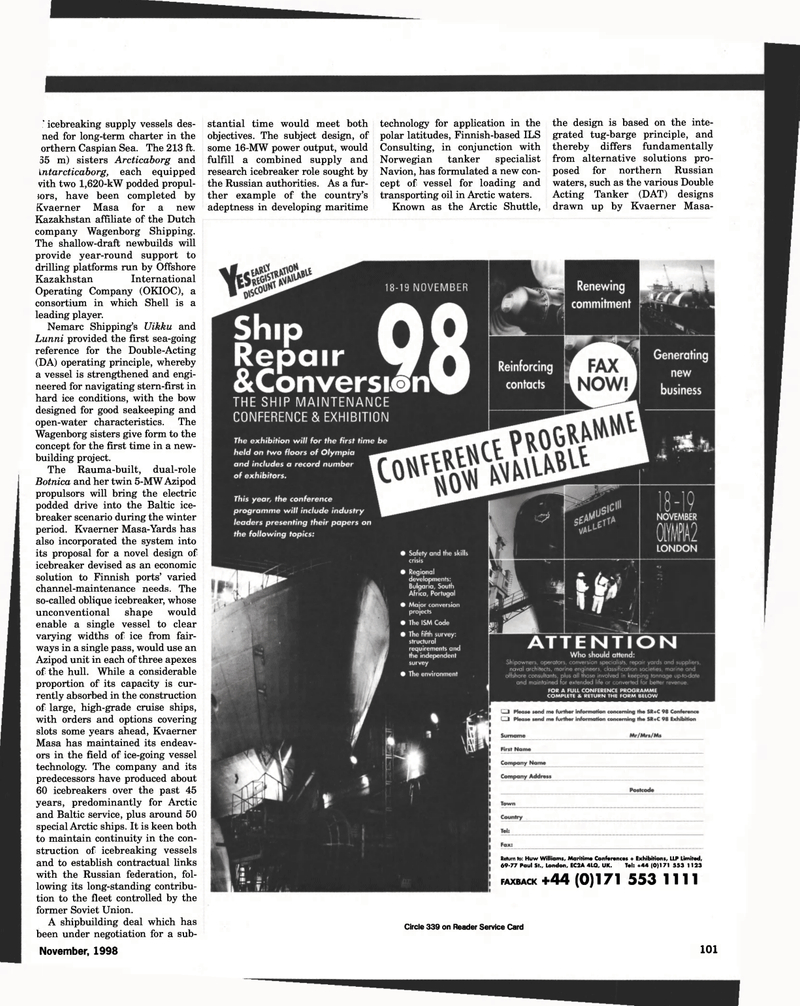
Page 101: of Maritime Reporter Magazine (November 1998)
Read this page in Pdf, Flash or Html5 edition of November 1998 Maritime Reporter Magazine
' icebreaking supply vessels des- ned for long-term charter in the orthern Caspian Sea. The 213 ft. 35 m) sisters Arcticaborg and
Vntarcticaborg, each equipped vith two 1,620-kW podded propul- sors, have been completed by
Kvaerner Masa for a new
Kazakhstan affiliate of the Dutch company Wagenborg Shipping.
The shallow-draft newbuilds will provide year-round support to drilling platforms run by Offshore
Kazakhstan International
Operating Company (OKIOC), a consortium in which Shell is a leading player.
Nemarc Shipping's Uikku and
Lunni provided the first sea-going reference for the Double-Acting (DA) operating principle, whereby a vessel is strengthened and engi- neered for navigating stern-first in hard ice conditions, with the bow designed for good seakeeping and open-water characteristics. The
Wagenborg sisters give form to the concept for the first time in a new- building project.
The Rauma-built, dual-role
Botnica and her twin 5-MW Azipod propulsors will bring the electric podded drive into the Baltic ice- breaker scenario during the winter period. Kvaerner Masa-Yards has also incorporated the system into its proposal for a novel design of icebreaker devised as an economic solution to Finnish ports' varied channel-maintenance needs. The so-called oblique icebreaker, whose unconventional shape would enable a single vessel to clear varying widths of ice from fair- ways in a single pass, would use an
Azipod unit in each of three apexes of the hull. While a considerable proportion of its capacity is cur- rently absorbed in the construction of large, high-grade cruise ships, with orders and options covering slots some years ahead, Kvaerner
Masa has maintained its endeav- ors in the field of ice-going vessel technology. The company and its predecessors have produced about 60 icebreakers over the past 45 years, predominantly for Arctic and Baltic service, plus around 50 special Arctic ships. It is keen both to maintain continuity in the con- struction of icebreaking vessels and to establish contractual links with the Russian federation, fol- lowing its long-standing contribu- tion to the fleet controlled by the former Soviet Union.
A shipbuilding deal which has been under negotiation for a sub-
November, 1998 stantial time would meet both objectives. The subject design, of some 16-MW power output, would fulfill a combined supply and research icebreaker role sought by the Russian authorities. As a fur- ther example of the country's adeptness in developing maritime technology for application in the polar latitudes, Finnish-based ILS
Consulting, in conjunction with
Norwegian tanker specialist
Navion, has formulated a new con- cept of vessel for loading and transporting oil in Arctic waters.
Known as the Arctic Shuttle, the design is based on the inte- grated tug-barge principle, and thereby differs fundamentally from alternative solutions pro- posed for northern Russian waters, such as the various Double
Acting Tanker (DAT) designs drawn up by Kvaerner Masa-
Return to: Huw Williams, Maritime Conferences + Exhibitions, LLP Limited, 69-77 Paul St., London, EC2A 4LQ, UK. Tel: *44 (0)171 553 1123
FAXBACK +44 (0)171 553 1111
Circle 339 on Reader Service Card 101

 100
100

 102
102
